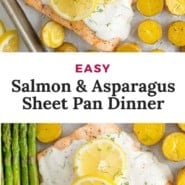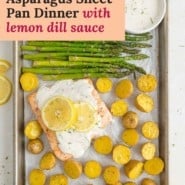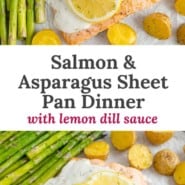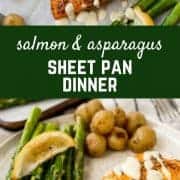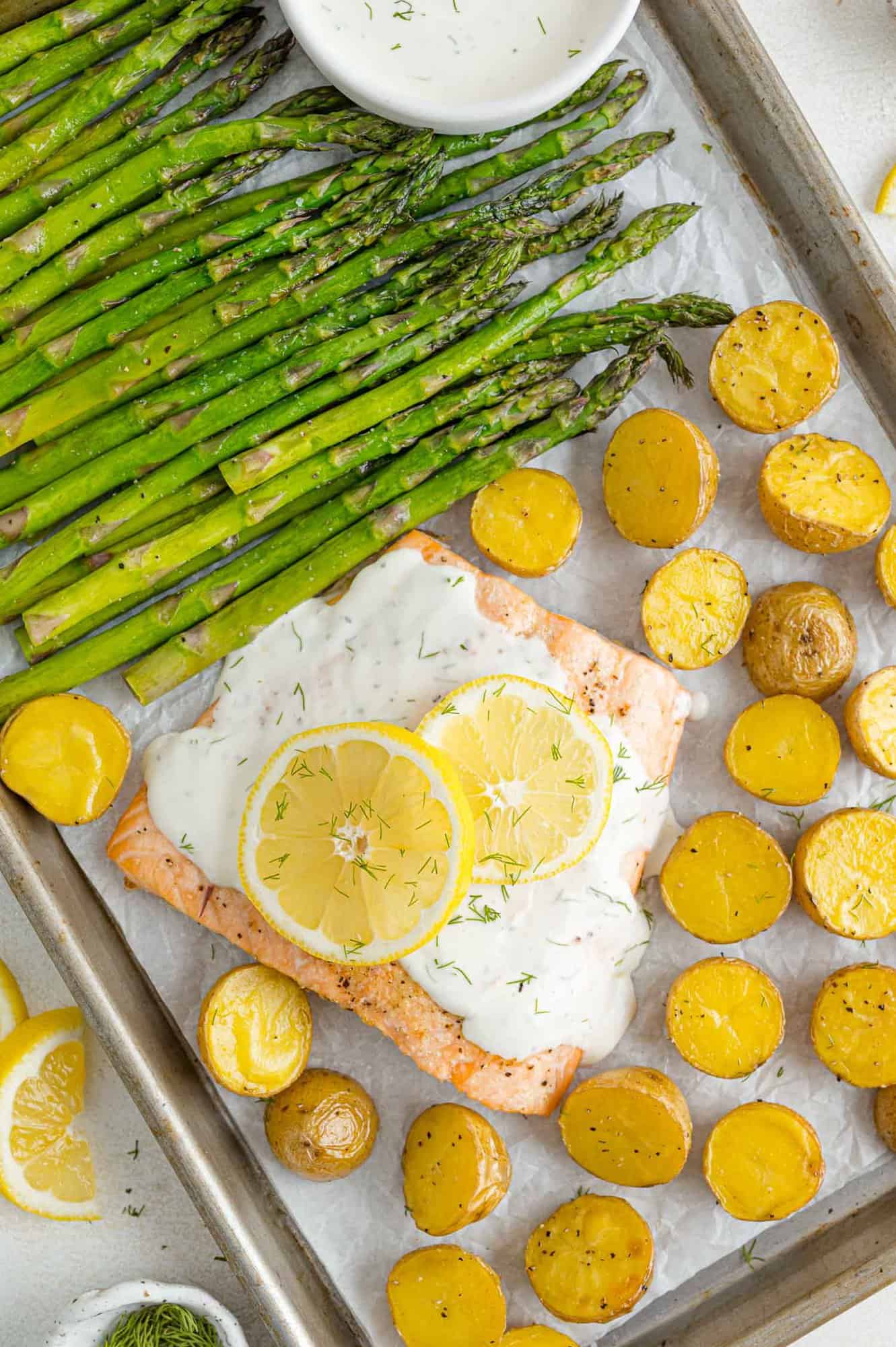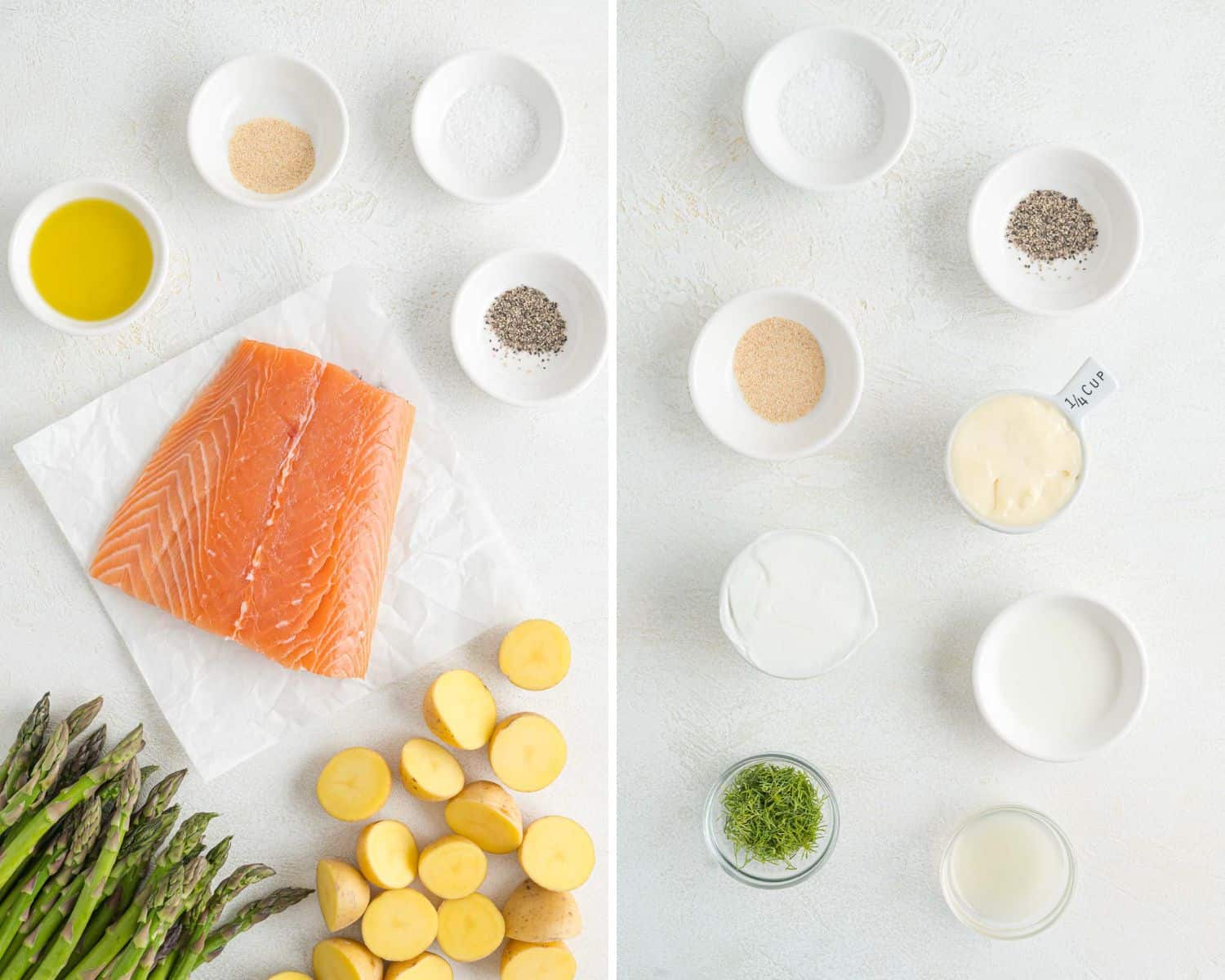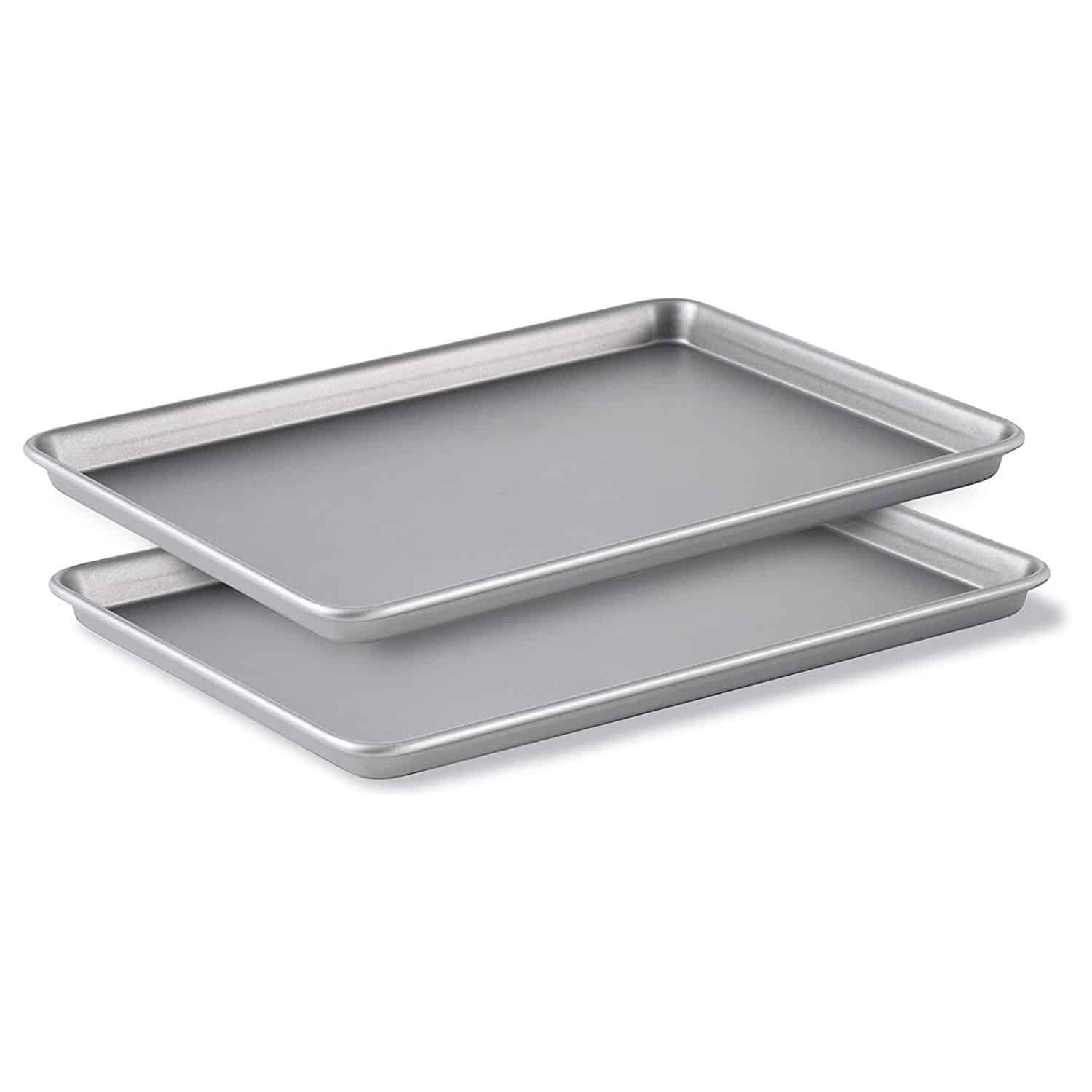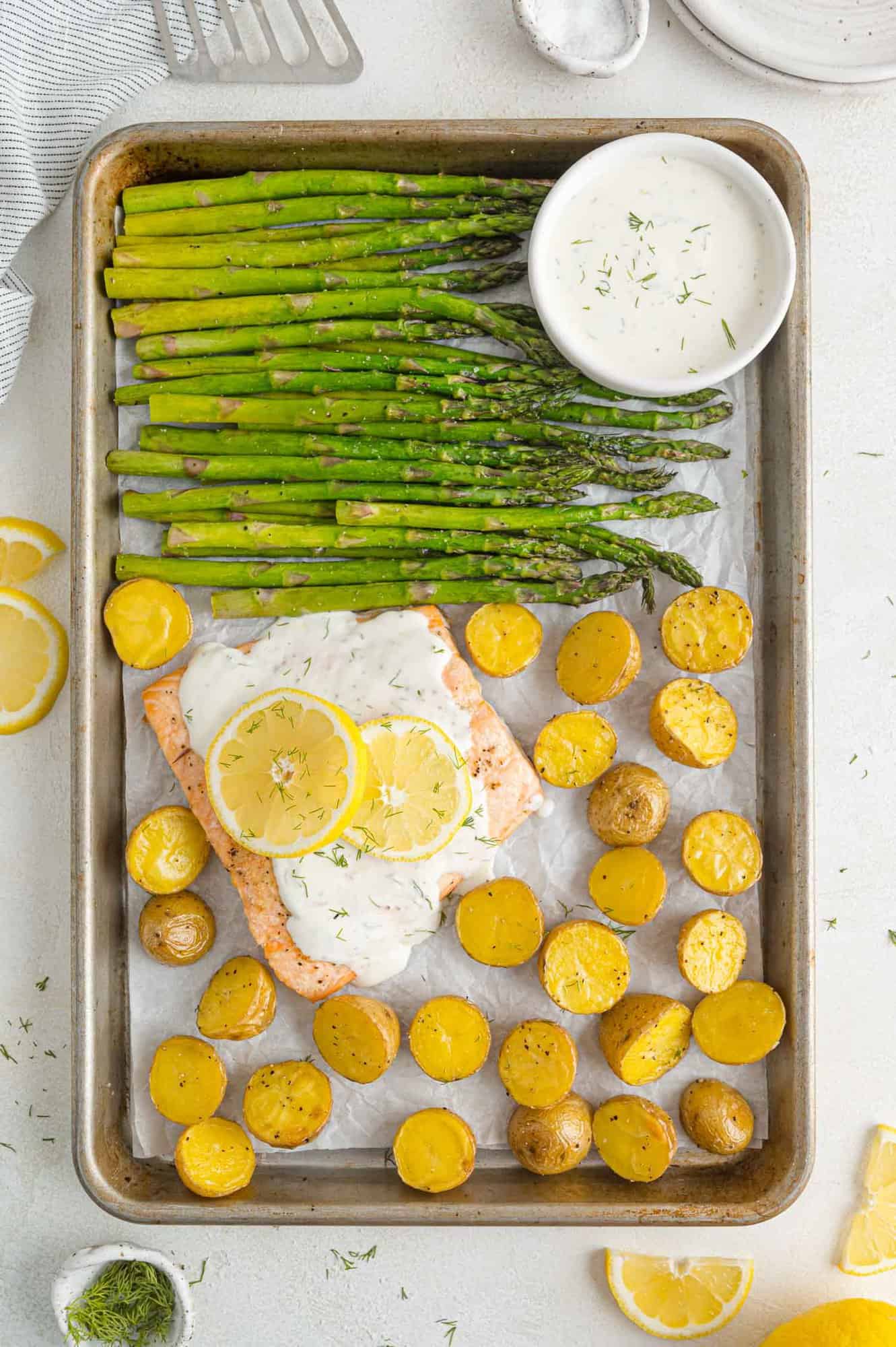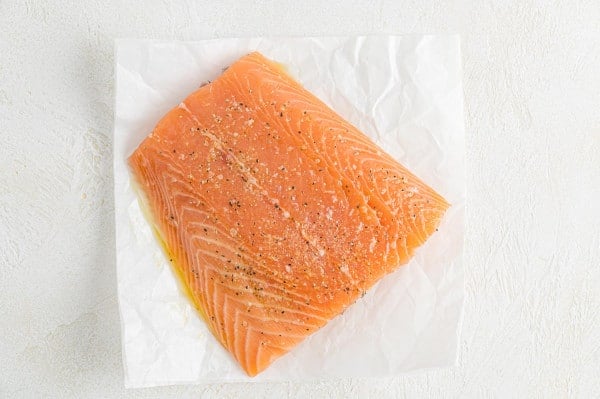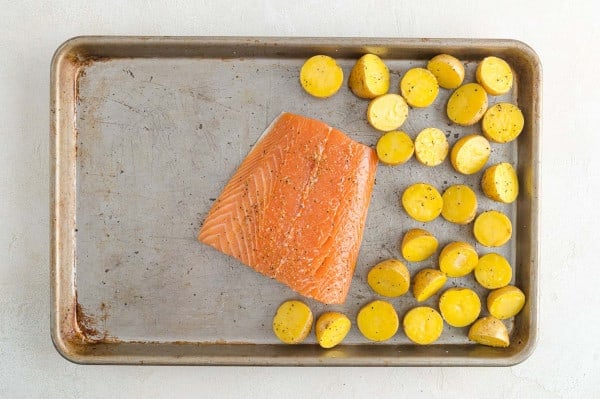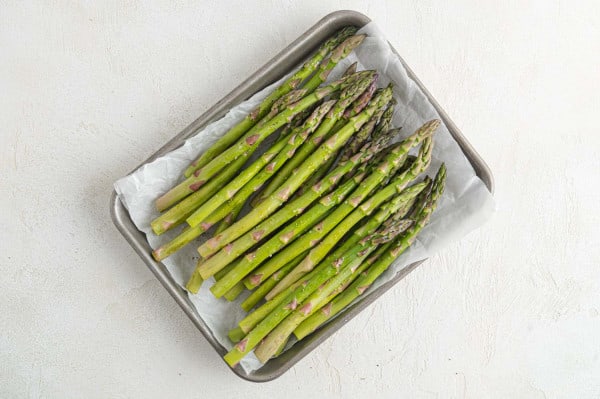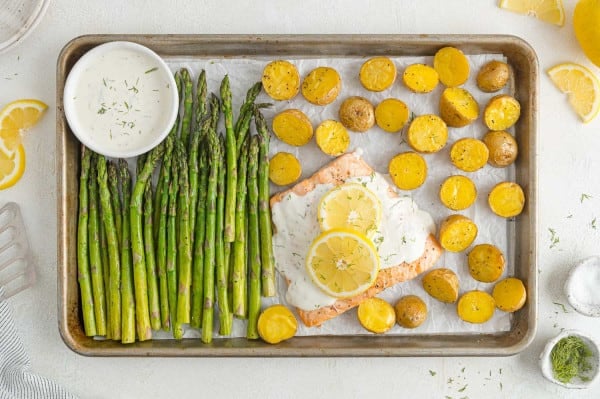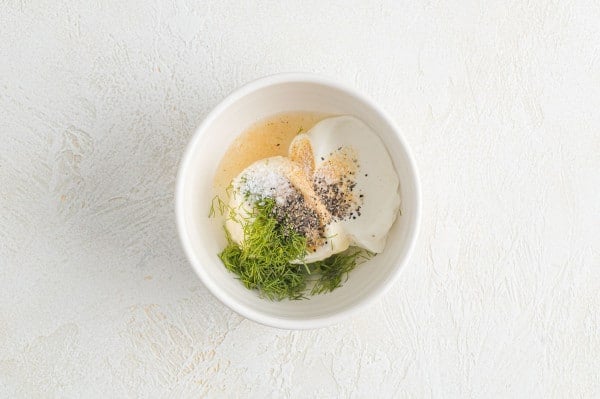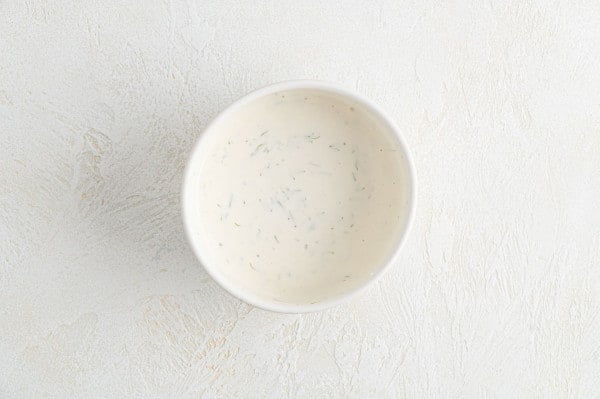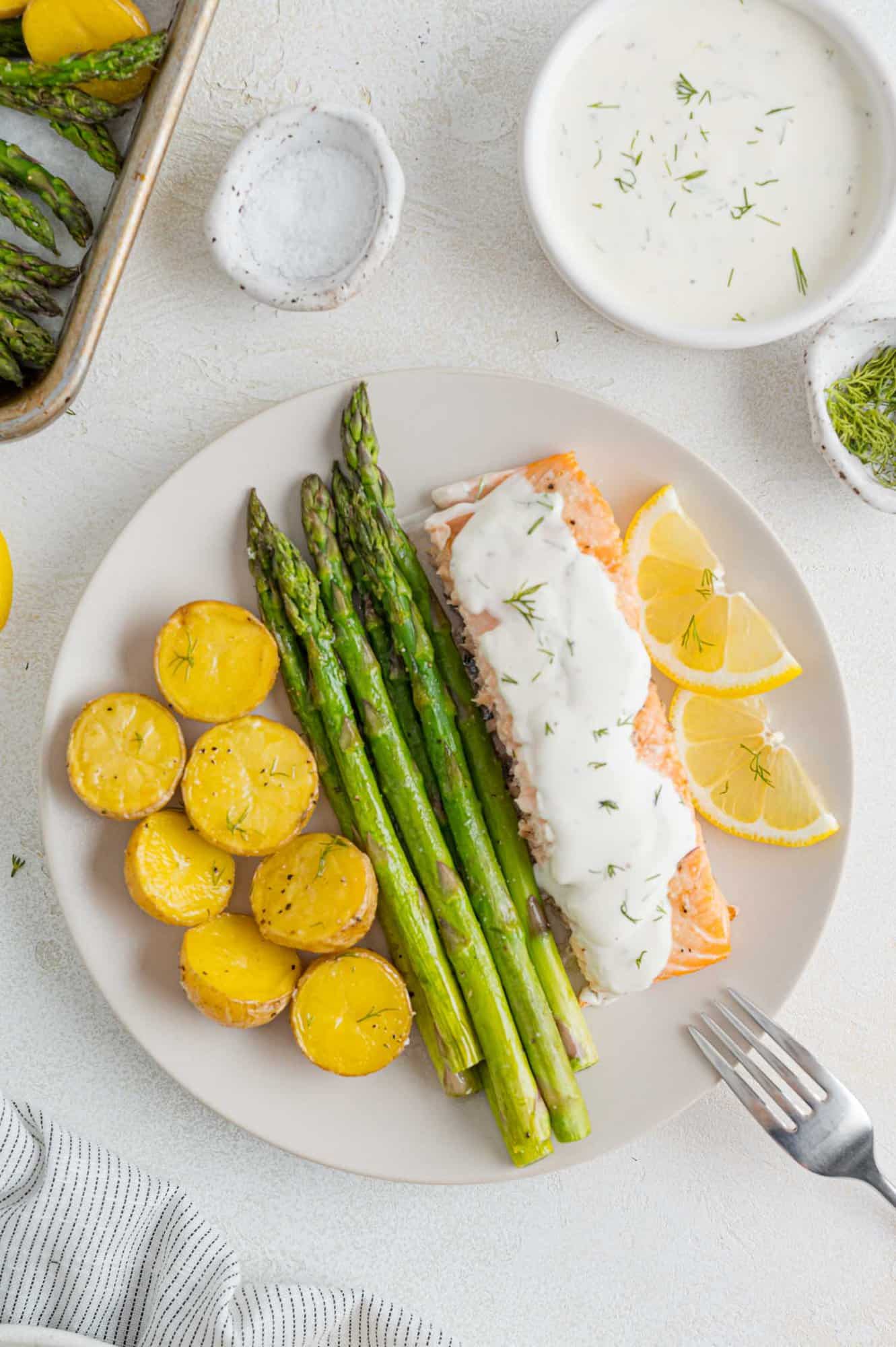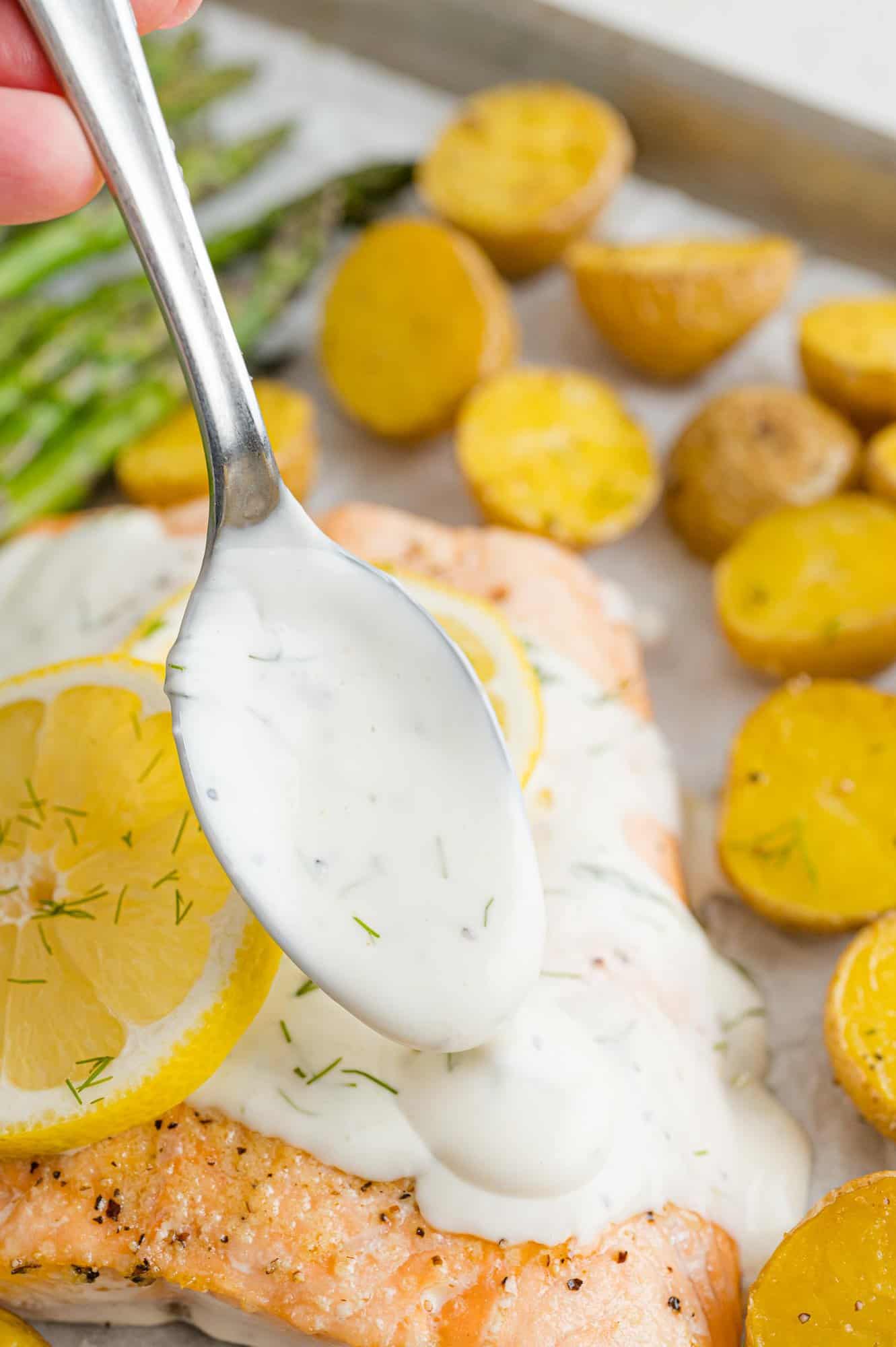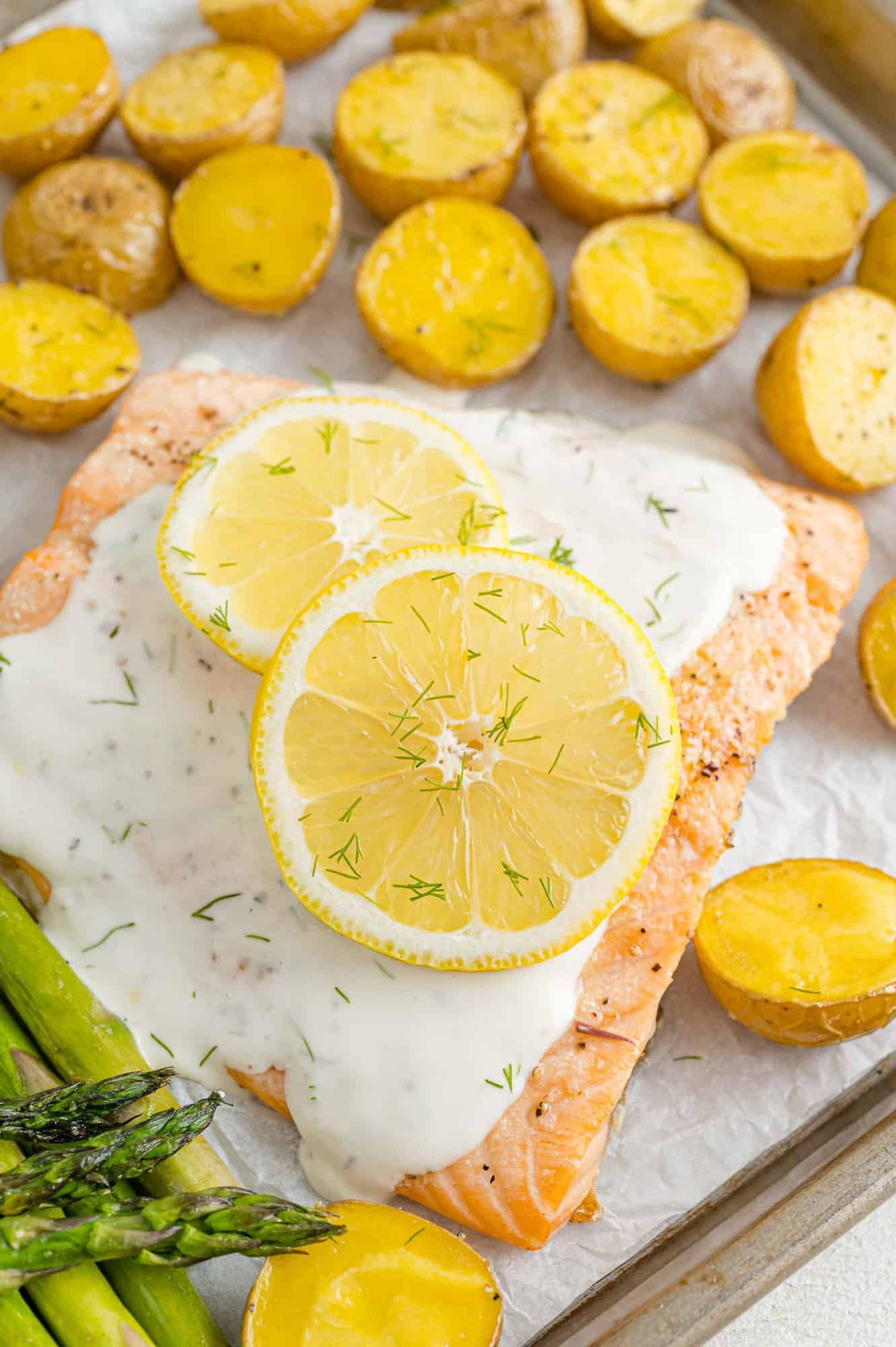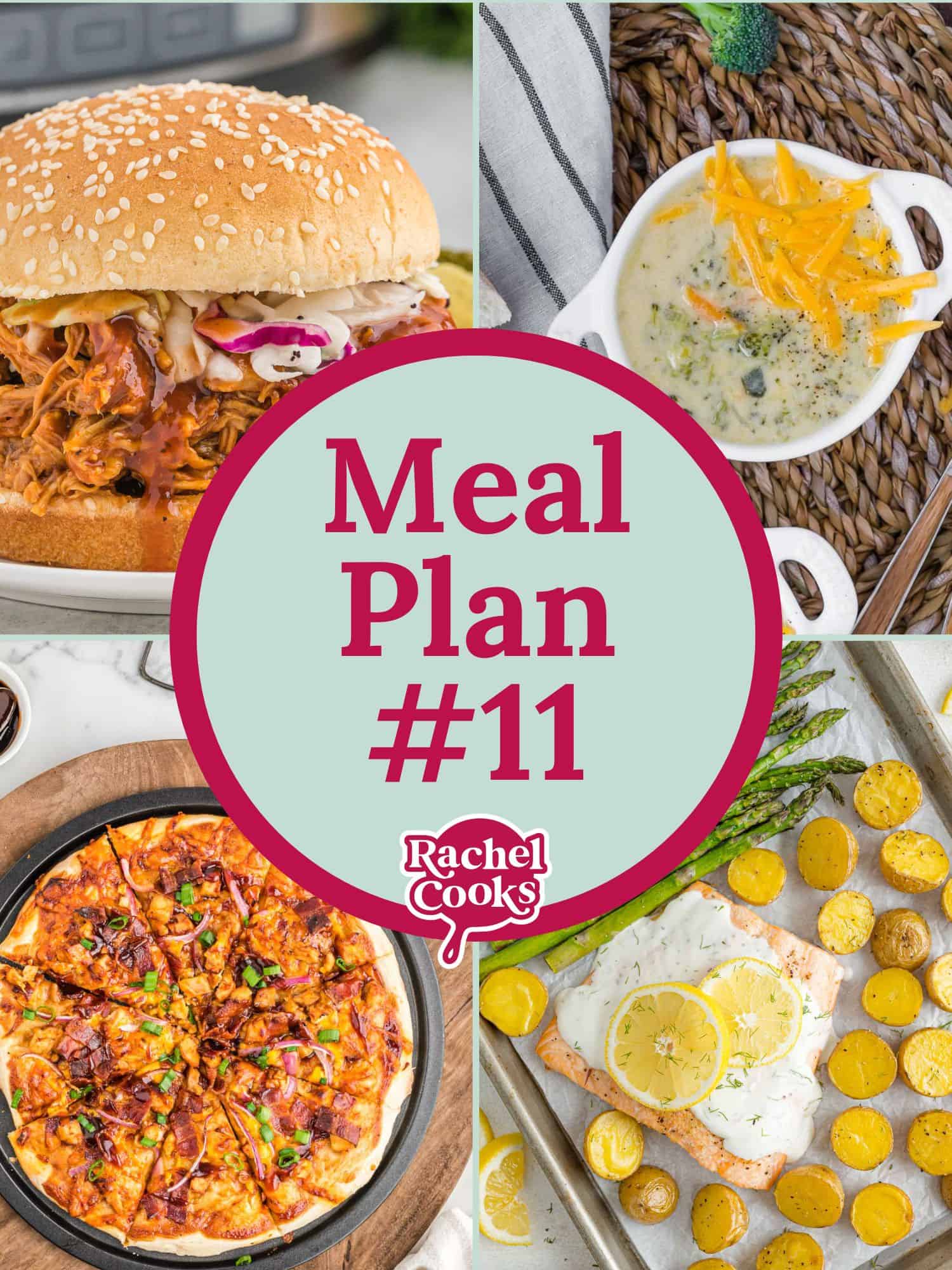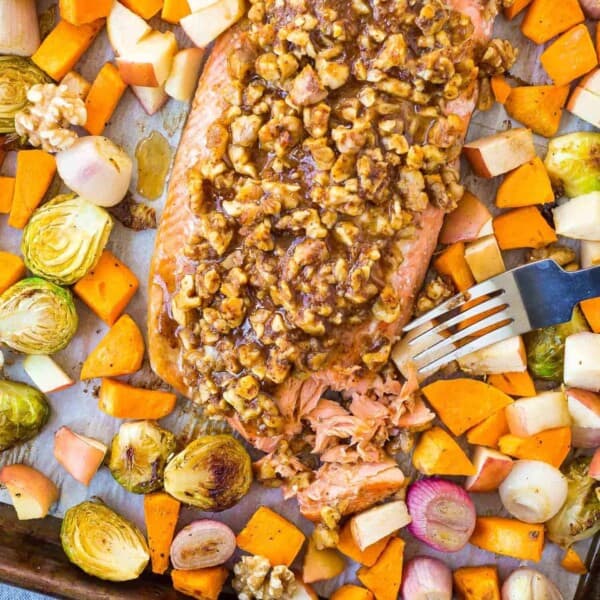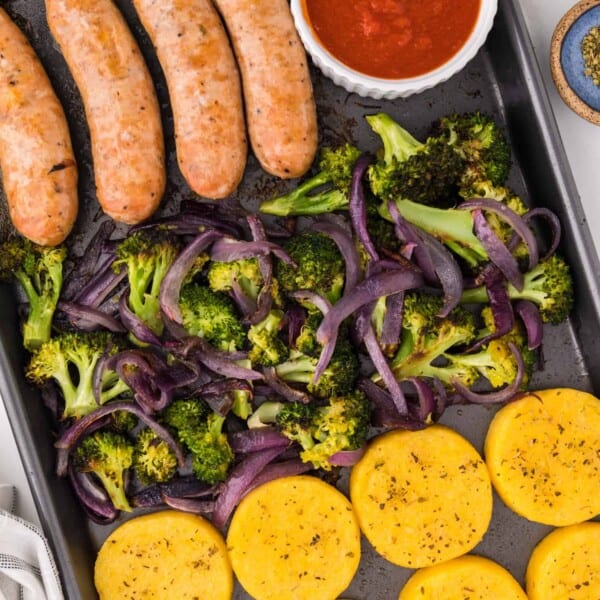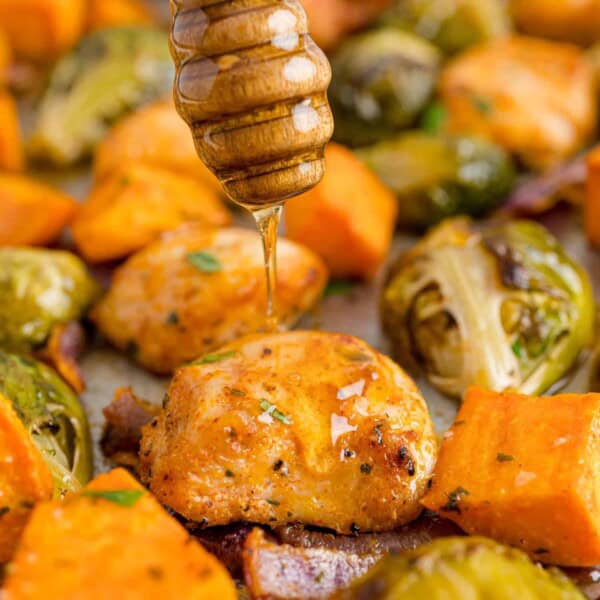Easy Salmon Sheet Pan Dinner With Asparagus
This salmon sheet pan dinner is a protein-packed, all-in-one meal that feels like a splurge but is actually super easy to make. This recipe has a juicy seasoned salmon filet, snappy asparagus, and tender potatoes roasted all in the same pan for a complete, satisfying family meal that you can make tonight! The sheet pan method leaves plenty of time to whip up a batch of fresh lemon dill sauce while your main and sides bake to perfection in the oven. How long it takes: just under an hour Equipment you’ll need: sheet pan, large bowl Servings: 2
Why You’ll Love This Salmon Sheet Pan Dinner
Ingredients You’ll Need
I’ll run through the ingredients for this sheet pan dinner to get you started. Look for complete instructions, measurements, and nutrition information on the recipe card below.
Salmon – You can buy skinless fillets or salmon with the skin on, it’s up to you. If you are using frozen salmon, thaw it overnight in the fridge or follow the package instructions for thawing. Asparagus – Look for one small bunch, about 10 to 12 spears, depending on how thick the spears are. The asparagus should be dark green, fairly firm, and crisp, with tight buds. Baby Potatoes – For visual appeal, look for mixed-colored potatoes. If you can’t find the teeny potatoes, use larger ones and cut them in half or bite-size chunks. Olive Oil – Often used for roasting vegetables, olive oil adds flavor and has a good smoke point. If you prefer, substitute avocado or grapeseed oil. Garlic Powder, Salt, and Pepper – Simple seasonings for the salmon, asparagus, and potatoes. If you want to add more pizzazz, try my all-purpose seasoning instead. Greek Yogurt – Full-fat or nonfat, or you can use regular plain yogurt instead. Full-fat yogurt will naturally make a richer sauce than nonfat but you decide. Mayonnaise – The sauce is 1:1 yogurt and mayo. We tested the recipe a few ways and decided it tasted best with some added mayonnaise. Milk – You’ll need just a bit to thin the sauce to your liking. Fresh Lemon Juice – Lemon, dill, and salmon just go together so well! The lemon juice gives the sauce a bright and tangy profile. Another recipe we love is baked lemon salmon with dill. Fresh Dill – Don’t you just love fresh dill? I like to put a “dill bouquet” in a jar on my kitchen counter so I can inhale that wonderful scent whenever I walk by. If you can’t find fresh dill, dry dill can be substituted. Use less, 2 teaspoons instead of 2 tablespoons.
How To Make a Salmon Sheet Pan Dinner
Prepare the seasoning. Begin by whisking together a seasoning blend of garlic powder, salt, and pepper. Roast the potatoes. Add the potatoes to a bowl with olive oil and ⅓ of the seasoning mix. Toss the potatoes until they are well coated with the oil, then arrange them in the pan. Roast the potatoes at 400ºF for 10 minutes.
Season the salmon. While the potatoes are roasting, prep the salmon. Rub the top with oil and season with another ⅓ of the seasoning. Bake. Take the sheet pan with the potatoes out of the oven, and add the salmon to the pan. Place it back into the oven (still at 400ºF) for 10 more minutes.
Add the asparagus. Meanwhile, season the asparagus with olive oil and the last of the seasoning mix. Remove the pan from the oven once again, and this time, arrange the asparagus on the pan and return it to the oven. Bake again. Bake the whole sheet pan for 5 to 10 minutes longer, or until the fish and veggies are done to your liking.
Make the Lemon Dill Sauce
I haven’t forgotten about the sauce! Make the lemony dill sauce during the “break times”, or before you get started. It’s up to you. To make the sauce:
Combine. Add all the ingredients to a bowl. Mix. Whisk everything until smooth. Serve! Plate the salmon, arranging the potatoes and asparagus to the side. Give the whole meal a generous drizzle with lemon dill sauce. Garnish with extra dill, if you like, and dig in.
Tips for Success
These are my tips for the best salmon sheet pan dinner:
Wondering how much salmon to buy? This recipe makes two servings, so you’ll need the appropriate amount of salmon. One serving of salmon is about three to four ounces, but I tend to err on the generous side and figure about five ounces each. Follow the recipe as written. This ensures that all of your ingredients cook to the right doneness. Start with the potatoes since they take the longest to get tender, then add the salmon, and finally, the asparagus. Test the salmon for doneness. Salmon is done cooking when the flesh flakes easily with a fork. The internal temperature should read 145ºF on an instant-read thermometer. Line the pan. If you want, line a sheet pan with parchment paper for extra easy cleanup.
Make This Salmon Dinner Your Own
Salmon and vegetables have plenty of flavor on their own, but there are plenty of other ways to adapt this salmon dinner, too. Try these ideas:
Not a fan of asparagus? Substitute green beans. They take a little longer to cook so you can add them to the pan with the salmon. Different salmon. Make this recipe with BBQ salmon or baked salmon with lemon, or try a variation with a crisp breading, like this almond-crusted salmon or a walnut-crusted salmon sheet pan dinner. Instead of the baby potatoes, try sweet potatoes, diced into bite-sized pieces. Try a different sauce. Homemade chimichurri with loads of parsley and garlic is fantastic with this dinner. Fresh-tasting tzatziki (cucumber yogurt sauce) is an amazing topper, too. Of course, good ol’ ranch dressing can stand in as a sauce, too, and no one will complain. Don’t want to turn your oven on? Try air fryer salmon! It’s easy and delicious.
What To Serve With Salmon
Pretty much any vegetable goes well with salmon, and asparagus is only the tip (spear?) of the iceberg. Green vegetables are always a good choice, such as roasted broccoli or quick-cooking sugar snap peas. Or, try green bean recipes like these green beans almondine, or roasted green beans with parmesan and basil. Still have room for dessert? Lemon meringue pie cookies (just for two!) are a perfect ending to this meal.
Make-Ahead Tip
To get a head start on dinner, make the sauce the night before. Refrigerate it until you’re ready to use it and give it a good stir before serving. The asparagus can be washed and trimmed ahead of time, too.
Storing and Reheating Leftovers
Fridge. Store any leftover salmon and veggies airtight in the fridge for up to 2 days. The salmon and veggies can be stored together, but keep leftover dill sauce in a separate container. Reheat. Reheat the salmon in the microwave or in the oven and add the sauce afterward.
Leftover Love
Turn your leftovers into an easy salmon salad. Add the leftover ingredients to a plate of your favorite greens, such as leaf lettuce or spinach. Add a few chopped tomatoes and drizzle with the leftover sauce. So good! Leftover salmon also tastes great served over a spring orzo salad or arugula salad. Quick-Start Guide!

